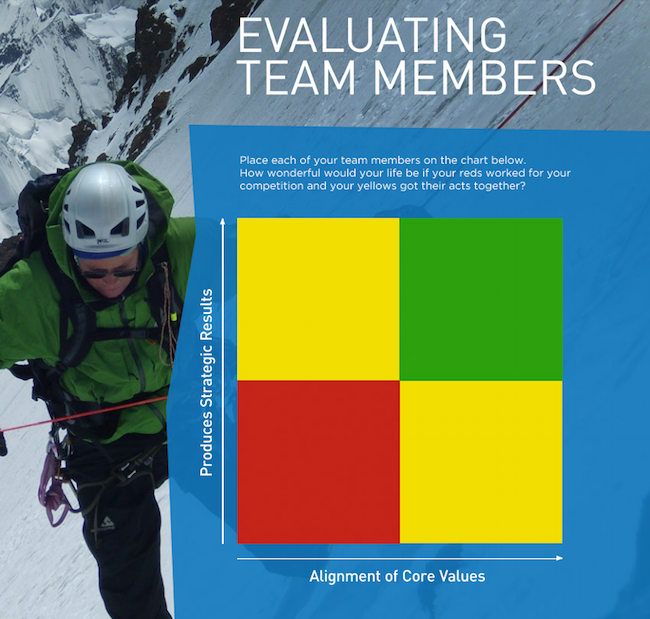
By Abree Murch
The leadership guru, John C. Maxwell once said that a leader “is one who knows the way, goes the way, and shows the way.” Following this mantra is Chris Warner, founder and CEO of Earth Treks, Inc. and all-around bad ass. Warner has had both a literal and figurative foot in all three of those areas at one time or another.
He is an accomplished climber and mountaineer who has led multiple expeditions on Everest and K2. He also teaches at the Wharton School of Business and advises organizations on leadership strategy, including Google, the Baltimore Ravens, and the US National Counterterrorism Task Force. CBJ sat down with Warner to get his thoughts on leadership in the indoor climbing industry and what climbing gym owners and operators can do to ensure their organizations are performing to their full potential.
The State of Leadership in the Climbing Industry
According to Warner, climbing gyms have an education problem: most people in leadership positions have never been formally trained. “Our leadership education tends to be a little more intuitive than it is intellectual,” Warner says. “We typically model behaviors that we see in other people. The problem with this idea is that quite often we’re taught how to lead by people who have never been taught how to lead.”
The modeling approach can become doubly destructive when leaders start modeling outdated behaviors. “There’s a big difference between someone who’s in their twenties now and someone who’s in their fifties now,” explains Warner. “I learned to lead from people who had a very engineering-based focus on the world. We were trying to make things more productive and more efficient.” Now, he says, leaders should be looking to an approach that parallels Maslow’s hierarchy of needs. The upcoming generation has moved beyond just being fed and clothed, and are looking for self-actualization, purpose, and meaning as components of their work life.
This phenomenon of intuition-based leadership paired with an outdated approach is one that afflicts many small to mid-sized businesses. Warner feels it’s particularly common in the climbing industry, but it’s something that can easily be addressed through training: “Until gym owners – and anybody running a mom-and-pop type business – really start to study leadership experts, until they’re properly coached, they’re just going to perpetuate the same problem.”
So where can gym owners, operators, and managers start?
Take an honest look in the mirror
Warner acknowledges that this is usually the hardest part for most leaders, but it’s the most critical. Edward Deming, one of the great early leadership thinkers, theorized that 80-95% of all problems within companies are caused by management. Warner agrees, estimating the true percentage to be closer to 80%, adding that “we know that 70% of businesses lose money or break even every year in the US. Only 1% of businesses gross over $10 million in sales. So there’s something that’s stopping these businesses from being successful.”
Warner likes to use the TV series The Office to illustrate why these 70% of businesses aren’t succeeding. He maintains that most businesses, including climbing gyms, have the same flawed pyramidal structure the show portrays. At the top of this hierarchy is the person who owns and/or runs the organization, a la Michael Scott. “In that spot, you also can write the word ’sociopath’,” says Warner, “because ultimately, what is a sociopath? Someone who believes the rules don’t apply to them.” He points out that this describes a lot of climbers: “We celebrate this – just look at the ‘dirtbag lifestyle’.”
At the very bottom of the pyramid are the economic “losers;” these might be the staff members who work without benefits for minimum wage or volunteer routesetters. However, Warner warns that while these people at the bottom may be seen as economic losers, “they’re pretty damn smart and heaven help the person at the top if they organize, because they will come after you with pitchforks!”
So the owner/operator of this flawed organization is forced to build in a bunch of clueless middle managers as a buffer between them and the people at the bottom. These middle managers are clueless because they don’t see what’s truly happening in the business and they’re not willing to question the sociopath at the top.
This, Warner says, is the model of business who break even or lose money every single year: a flawed leader at the top, people at the very bottom who suffer because of this flawed leadership, and a bunch of people in the middle who are clueless and don’t know how to identify or fix the problem. True change hinges on key leaders acknowledging their faults and that they may be the person at the top of the pyramid.
Realize gyms are in the business of behavior
To operate a climbing gym that counts itself in the 30% of businesses that make money, Warner points to three drivers of results: “One is you bring the right tools – you build the perfect gym in the perfect location. Second, is the techniques – you apply sound financing and accounting techniques, and follow industry practices. Thirdly, is the behaviors of the organization, the behaviors of your staff.”
For the most part, climbing gyms are all competing with the same tools and techniques. The holds, ropes, and walls all come from the same places, and the basic technicalities of running a gym don’t vary too much from place to place. Therefore, according to Warner, competition really occurs on only one of these fronts: behavior.
“On the behavior side, you can take a podunk little gym in a bad location and you can make a LOT of money because your team exceeds the other teams in the area.” He points to bars as an example. “How many bars are in your town? One bar is always going to be doing better than the other bars because their staff are friendlier, they’re better trained, etc.”
This is where all businesses need to understand that their greatest ability to drive results or profitability is in the behaviors of their staff. By extension, leaders within organizations have to learn what “mission-critical behaviors” their staff should have and what they can do to encourage those behaviors.
Hire the right people and don’t screw them up
In order to find and keep staff members that display these mission-critical behaviors, gym leaders need to have a conscious way of judging people. Warner recommends plotting existing and potential employees on a chart that maps a person’s ability to deliver strategic results against their alignment with the organization’s core values.

To be successful, a leader needs to cultivate the “green people” – team members that fall into the green section, who do their jobs well and add value to the team. New hires are usually already there and Warner asserts that “most people who work in climbing gyms are decent people.” So how do these good employees get screwed up? Usually, it’s a case of needs being unmet.
Warner cites six psychological needs that must be met in order for a person to perform optimally as part of a team:
“If you’re not taking care of those needs, you’re screwing people up,” he explains. For instance, a “green” experienced staff member is going to become demotivated and fall into the yellow or red if their need for growth isn’t met and they’re confined to the front desk even after they’ve mastered the position.
The need for autonomy works in a similar way. “The day someone starts to micromanage you, you become dysfunctional,” Warner explains. He cites Earth Treks’ decision to change their approach to front desk staffing as an example. Initially, staff had a never-ending to-do list of cleaning tasks, but they ended up being so busy that the quality of customer service suffered.
Now, his facilities staff more people while giving them less to do. Though over-staffing is one of the criticisms Warner receives to his face most often, it’s paid off and he sticks by his approach: “The thing is, if you’re bored at the front desk, you give great customer service because you’re desperate to do something other than be bored!”
In order to be sure they’re meeting their team’s needs, Warner advises leaders to create a spreadsheet listing their employees across the top and each of the six psychological needs down the side. Each week, leaders should judge themselves honestly on whether they’ve meet these needs for each employee, keeping in mind that the approach will likely vary from person to person.
Make hard decisions
Have you ever dealt with someone who is great at what they do, but absolutely miserable to spend time with? “There’s nothing worse than when you have someone who delivers strategic results but doesn’t align with your core values,” Warner says. These people can be incredibly toxic to organizations because leadership is reluctant to let them go.
There are other factors that can affect team member’s performance that are beyond anyone’s control. It’s plausible that someone is a good fit when they’re hired, but something happens in the 13th month of employment that causes them to lose their spark, from a car accident that changes their financial situation, to a divorce or break-up, to a death in the family.
So how do you know when it’s time to remove a member of the team? When a team member starts exhibiting performance problems, the first step is to honestly evaluate whether leadership is meeting the person’s six psychological needs. If it’s determined that the problem is related to an issue besides management, Warner suggests meeting with the person and seeing what can be done to support or coach them if needed.
From this point on, he subscribes to “The Rule of Threes”: if three or more people spend three or more hours working to fix the problem, but there’s little to no progress, that person needs to go. “If you don’t let them go, you’re actually hurting the situation,” Warner explains, “because an organization needs to be catering towards the ‘green people’.” It takes quite a number of meetings to reach the three-hour mark and doesn’t make sense to demotivate your existing team members by forcing them to suffer because one person has a problem that can’t be reasonably remedied.
Be adaptable
Good leaders will have the ability to tailor their leadership based on the size of their organization. Managers of smaller gyms have an advantage in that they can more easily get to know their staff members and lead in a large degree by example. As the size of the organization increases, however, that ability decreases. “When you get to an organization the size of Earth Treks with 300-plus, you cannot lead by example anymore,” explains Warner. “You also need to be aware of your place.”
For instance, if the CEO of a large gym chain witnesses a birthday party belayer make a minor mistake and confronts them about it, the weight of the CEO’s authority can blow the situation out of proportion. Instead, the CEO should go to the belayers supervisor and get them to talk to the person. “My job at Earth Treks when the organization gets to this size is to make people happy that they work for the company,” Warner says. “It’s definitely not to micromanage anybody.”
Warner encourages climbing gym owners and operators to become lifelong students of business leadership, even if they’ve never studied the concept before. “If this is your first job as a manager and someone tells you to go out and make people know you care, go out and do it poorly a thousand times,” he states. Team members would rather see leaders try to make positive changes than see no effort at all. As Warner says, “If your intention is good, then people will forgive you.”

Climbing Business Journal is an independent news outlet dedicated to covering the indoor climbing industry. Here you will find the latest coverage of climbing industry news, gym developments, industry best practices, risk management, climbing competitions, youth coaching and routesetting. Have an article idea? CBJ loves to hear from readers like you!







